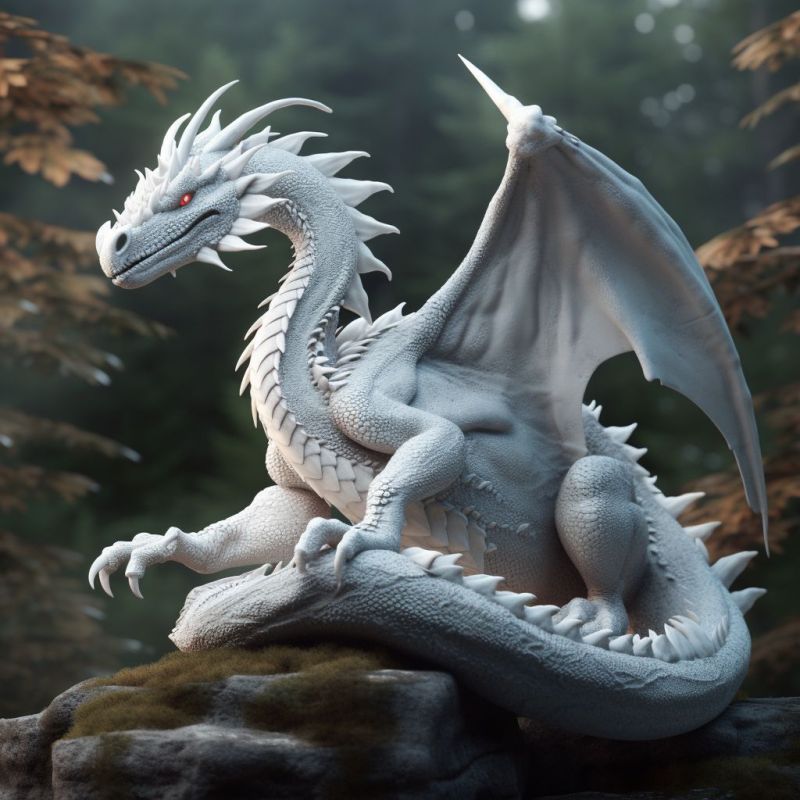 Abilities:
Abilities:-
Cold Breath Weapon (15) (5d8)
 Attack Abilities:
Attack Abilities:-
Cold Bite (d4)400 gp
 Monster Bits:
Monster Bits:-
4 Animal Bone0.03 gp
-
8 Animal Fat0.5 gp
-
15 Animal Meat0.05 gp
-
4 Dragon Blood10 gp
-
5 Hard Skin0.1 gp
-
6 White Dragon Scale25 gp
An unnatural cold accompanies the draconic creature, roughly the size of a large dog, with scales that gleam the stark, crystalline white of diamond. It stalks at a distance, measured in its movement but obviously predatorial. It flashes curved, wicked teeth as it opens its maw to exhale a gout of frost.
🔥 The Malevolent Chromatic Dragons
Chromatic dragons are the embodiment of primal terror and unrelenting malice, their vibrant scales and devastating powers striking fear into the hearts of all who dwell in their shadows. These iconic titans of malevolence stand in stark contrast to their metallic kin, driven by greed, cruelty, and an insatiable desire for domination. Each chromatic dragon is a unique force of destruction, their lairs and legends shaping the landscapes and nightmares of the world.
🖤 Black Dragon: The Shadow of Desolation
Lurking in the festering depths of swamps, marshes, and crumbling ruins, black dragons are masters of stealth and treachery. Their ebony scales, dull and mottled with age, blend seamlessly into the murky gloom, making them near-invisible predators. Renowned for their cunning, they orchestrate ambushes with chilling precision, striking from shadows or submerged waters to dissolve flesh and metal with their corrosive acid breath. Black dragons revel in the collapse of civilizations, hoarding relics of fallen kingdoms and sowing despair among the weak. Their sadistic cruelty and volatile tempers make them as unpredictable as they are deadly, turning their blighted domains into graveyards of ambition.
⚡️ Blue Dragon: The Tempestuous Tyrant
Blue dragons soar over sun-scorched deserts, windswept steppes, and rocky coasts, their sapphire scales gleaming like the heart of a storm. These arrogant sovereigns rule their arid territories with iron claws, unleashing lightning breath that splits stone and incinerates foes. Masters of elemental magic, they summon thunderstorms to herald their wrath, their lairs crackling with static and the scent of ozone. Vain and territorial, blue dragons brook no rivals—especially the gregarious brass dragons—and their strategic minds ensure victory through calculated strikes. They plunder caravans and settlements for wealth, hoarding sapphires and electrum as symbols of their unchallenged dominion.
🌿 Green Dragon: The Cunning Enigma
Slipping through the dense canopies of ancient forests, green dragons are the epitome of manipulation and deceit. Their emerald scales blend with foliage, masking their presence as they weave intricate webs of subterfuge. Masters of psychological warfare, they bend creatures to their will through lies, intimidation, and poisonous breath that chokes the life from their victims. Green dragons delight in corrupting the virtuous, playing political games to destabilize kingdoms or turning allies into unwitting pawns. Their lairs, shrouded in acrid fog, are mazes of paranoia and treachery, where even the most cautious fall prey to their venomous schemes.
🔥 Red Dragon: The Infernal Monarch
Red dragons reign as unchallenged tyrants in the hearts of volcanoes and scorched wastelands, their molten-red scales radiating heat like a furnace. Driven by insatiable greed and boundless arrogance, they amass vast hoards of gold, rubies, and enchanted relics, guarding them with fiery breath that melts steel and bone. These dragons embody raw, destructive power, their tactical brilliance and aerial prowess making them nigh-invincible in battle. Red dragons rule through fear, demanding tribute and crushing defiance with cataclysmic fury. Their lairs, choked with sulfur and littered with the charred remains of challengers, are monuments to their unrelenting supremacy.
❄️ White Dragon: The Frigid Recluse
In the frozen abysses of arctic tundras and glacial caverns, white dragons stalk their icy domains with frost-covered scales that shimmer like fresh snow. The most primal and reclusive of their kind, they are driven by hunger and a savage need for isolation. Their icy breath freezes prey in an instant, and they hoard the frozen corpses of foes as grim trophies. Though less cunning than other dragons, their extraordinary memories fuel relentless vendettas, particularly against silver dragons who share their territories. White dragons tolerate only the strongest servants, ruling kobolds or frost giants through fear, their lairs a treacherous maze of ice and stone where solitude is both shield and weapon.
🌑 Architects of Terror
Chromatic dragons are the ultimate adversaries, each a unique embodiment of malevolence that tests the courage and ingenuity of any who dare oppose them. Their lairs—swamps of decay, deserts of lightning, forests of poison, volcanoes of flame, or tundras of ice—are as deadly as the dragons themselves, shaped by their magic and malice. In a campaign, these creatures are more than monsters; they are forces of nature, their sinister plots and devastating powers driving epic quests and moral challenges. Heroes must navigate treacherous encounters, unravel intricate schemes, or face the raw might of these dark sovereigns to claim victory. To confront a chromatic dragon is to challenge the heart of evil itself, forging legends in the crucible of their wrath.
Appearance:
Dragon Wyrmlings are the youngest and smallest form of dragons, usually no larger than a large dog. Their scales, though still developing, show the distinct color of their type—brilliant blue, fiery red, shimmering gold, or another hue. Their eyes are large and curious, filled with the promise of their future power.
Behavior:
Wyrmlings are highly inquisitive and often display a mixture of playful curiosity and fierce territoriality. They are still learning about their abilities and the world around them, making them unpredictable. Despite their small size, they can be aggressive if they feel threatened or if their territory is encroached upon.
Abilities:
Even at this young age, Dragon Wyrmlings possess a breath weapon unique to their species, whether it be fire, ice, lightning, or poison. They are also capable of flight, though their wings are not yet strong enough for long distances. Their claws and teeth are sharp, and their scales provide decent protection.
Habitat:
Wyrmlings are usually found in the same environments as their adult counterparts—caves, forests, mountains, or underwater lairs. They often remain close to their hatching sites, which are typically well-hidden and guarded by one or both parents.
Development:
As they grow, Dragon Wyrmlings rapidly learn and adapt, both physically and mentally. They undergo several stages of molting, where their scales harden and their powers strengthen. This period is crucial for their survival, as they are most vulnerable during these transitions.
Role in the World:
Dragon Wyrmlings can serve as early adversaries or allies to adventurers. Their lairs often contain minor treasures and clues to greater draconic secrets. Interactions with wyrmlings can foreshadow encounters with more formidable dragons, providing rich storytelling opportunities.
-
 Speed:
Speed:
-
 Walking Speed:
+30
Walking Speed:
+30
-
 Flying Speed:
+60
Flying Speed:
+60
 Special Senses:
Special Senses:-
 Nightsight: +60
Nightsight: +60
-
 Blindsight: +10
Blindsight: +10
 Natural Armor:
Natural Armor:-
Natural Armor +60 gp
 Natural Weapon(s):
Natural Weapon(s):-
Bite (d10)
 Extra Attack: +1
Extra Attack: +1
 Skill Tier 1:
Skill Tier 1:-
 Common Language Skill
Common Language Skill
 Skill Tier 2:
Skill Tier 2:-
 Bending Weapon Skill
Bending Weapon Skill -
 Draconic Language Skill
Draconic Language Skill -
 Natural Armor Skill
Natural Armor Skill -
 Natural Weapon Skill
Natural Weapon Skill
 Skill Tier 4:
Skill Tier 4:-
 Fortitude
Fortitude -
 Sneak
Sneak -
 Willpower
Willpower
❄️ The Savage White Dragon
The smallest and most feral of the chromatic dragons, white dragons are primal forces of hunger and greed, thriving in the harshest frozen wastelands. These vicious, cruel reptiles haunt arctic plains and icy peaks, driven by an unrelenting instinct to hunt, kill, and hoard. Their presence chills the soul as much as the body, marking them as relentless predators of the frostbound wilds.
🐾 Feral and Frostbound Form
A white dragon’s sleek, predatory profile is defined by feral, glinting eyes and a jagged, spined crest that runs from its brow to its tail. A wyrmling’s scales shimmer with the pure, blinding white of fresh snow, perfectly suited to their icy domains. As the dragon ages, its pristine sheen dulls, and patches of pale blue and light gray mottled across its hide, blending seamlessly with ice and stone. This camouflage allows it to vanish against snowy cliffs or fade into cloud-streaked skies while soaring. Its lean, muscular frame is built for agility, with powerful claws that grip ice as easily as a bat clings to stone, and wings that cut through frigid winds with eerie silence.
⚔️ Primal and Vengeful Hunters
Lacking the cunning strategies of other dragons, white dragons embody raw, animalistic power, making them the most relentless hunters among dragonkind. Their focus is singular: survive, slaughter, and dominate. They consume only frozen flesh, savoring prey killed by their icy breath while it remains rigid and cold. Other kills are entombed in ice or buried in snow near their lairs, creating gruesome larders that signal their presence. The frozen corpses of their greatest foes—giants, remorhazes, or rival dragons—are displayed as grim trophies, arranged in their lairs to gloat over past triumphs and warn intruders.
Despite their limited intellect, white dragons possess an uncanny memory, recalling every insult, defeat, or slight with crystalline clarity. They pursue vendettas with obsessive malice, targeting offenders—especially silver dragons, whose territories overlap theirs—with relentless cruelty. Though capable of speech, they rarely speak, their growls and roars conveying more than words ever could. When provoked, their rage is a blizzard of violence, unforgiving and absolute.
🐺 Lone Masters of the Frost
White dragons shun all company, even other dragons, save for brief pairings with mates of their kind to produce offspring. These unions are fleeting, as they flee back to solitude once their purpose is fulfilled. They tolerate no rivals near their lairs, attacking any creature they encounter, deeming them either too weak to deserve life or too strong to be allowed to exist. The only beings they permit are those who prove their worth through strength or cunning, such as dragon-worshiping kobolds or hardy humanoids who endure the dragon’s brutal hunger. These servants face constant peril, as the dragon’s appetite claims many.
Powerful beings, like frost giants, sometimes subjugate white dragons through displays of overwhelming might. A defeated white dragon may grudgingly serve such a master, channeling its ferocity to dominate lesser creatures in its stead. Yet, these alliances are fragile, as the dragon’s pride chafes under any yoke, and betrayal is never far from its thoughts.
💎 Treasure Under Ice
White dragons covet treasures that mirror the cold beauty of their realms, with a particular obsession for diamonds that sparkle like frozen stars. In their remote arctic lairs, their hoards often include walrus and mammoth tusk ivory, whale-bone carvings, ship figureheads from vessels lost to icy seas, thick furs, and enchanted relics plundered from foolhardy adventurers. Loose coins and gems are scattered across their lairs, glinting like constellations when struck by light. Larger treasures—chests, artifacts, or weapons—are encased in thick rime from the dragon’s breath, locked beneath layers of ice only its immense strength can shatter. Lesser creatures must toil for hours to chip or melt their way to the hoard, often perishing before they succeed.
A white dragon’s flawless memory catalogs every item in its hoard, each coin or gem tied to a specific victory or kill. This makes bribery nearly impossible, as they view offerings as an affront to their ability to simply take what they desire through slaughter. To a white dragon, wealth is a trophy of dominance, not a tool for trade.
🏔️ A White Dragon’s Lair
White dragons carve their lairs in the heart of eternal winter—icy caves, subterranean glacial chambers, or windswept mountain vales accessible only by flight. They favor vertiginous caverns where they can soar to lofty perches or slither through icy crevasses, clinging to walls like monstrous bats. Their lairs are labyrinths of frost and stone, with floors littered with jagged ice, hidden pits, and slick slopes that confound intruders. From high ledges or cliffside roosts, the dragon surveys its domain, unleashing its freezing breath to annihilate foes struggling below.
A legendary white dragon’s magic intensifies the cold around its lair, flash-freezing mountain caverns and turning the air brittle with frost. The keening winds that howl through its domain shift in tone when intruders approach, alerting the dragon to their presence. The lair’s environment is as deadly as the dragon itself, a frozen gauntlet that tests the endurance of any who dare enter.
🌬️ Lords of Ice and Instinct
White dragons are the embodiment of winter’s cruelty, ruling their domains through fear and raw power. They demand no tribute, for they take what they want, leaving only devastation in their wake. Their simplicity is their strength—unburdened by complex schemes, they act with brutal efficiency, driven by instinct and an unyielding will to survive. Yet, their predictable savagery can be their downfall, as cunning foes may exploit their lack of subtlety. To face a white dragon is to confront the unrelenting fury of a blizzard made flesh, but to outsmart one is to claim a victory over nature’s most primal wrath.
-
 Speed:
Speed:
-
 Swimming Speed:
[speed_walking]
Swimming Speed:
[speed_walking]
-
 Burrowing Speed:
[speed_walking]*0.5
Burrowing Speed:
[speed_walking]*0.5
 Damage Type Immunity:
Damage Type Immunity:-
 Cold
Cold
 Immune to Status Effect:
Immune to Status Effect:-
 Chilled
Chilled -
 Freezing
Freezing
 Creature Type Monster Bits:
Creature Type Monster Bits:-
0.12 White Dragon Scale25 gp
 Passive Abilities:
Passive Abilities:-
Amphibious1000 gp
-
Ice Walk500 gp
Environment:
![]()
